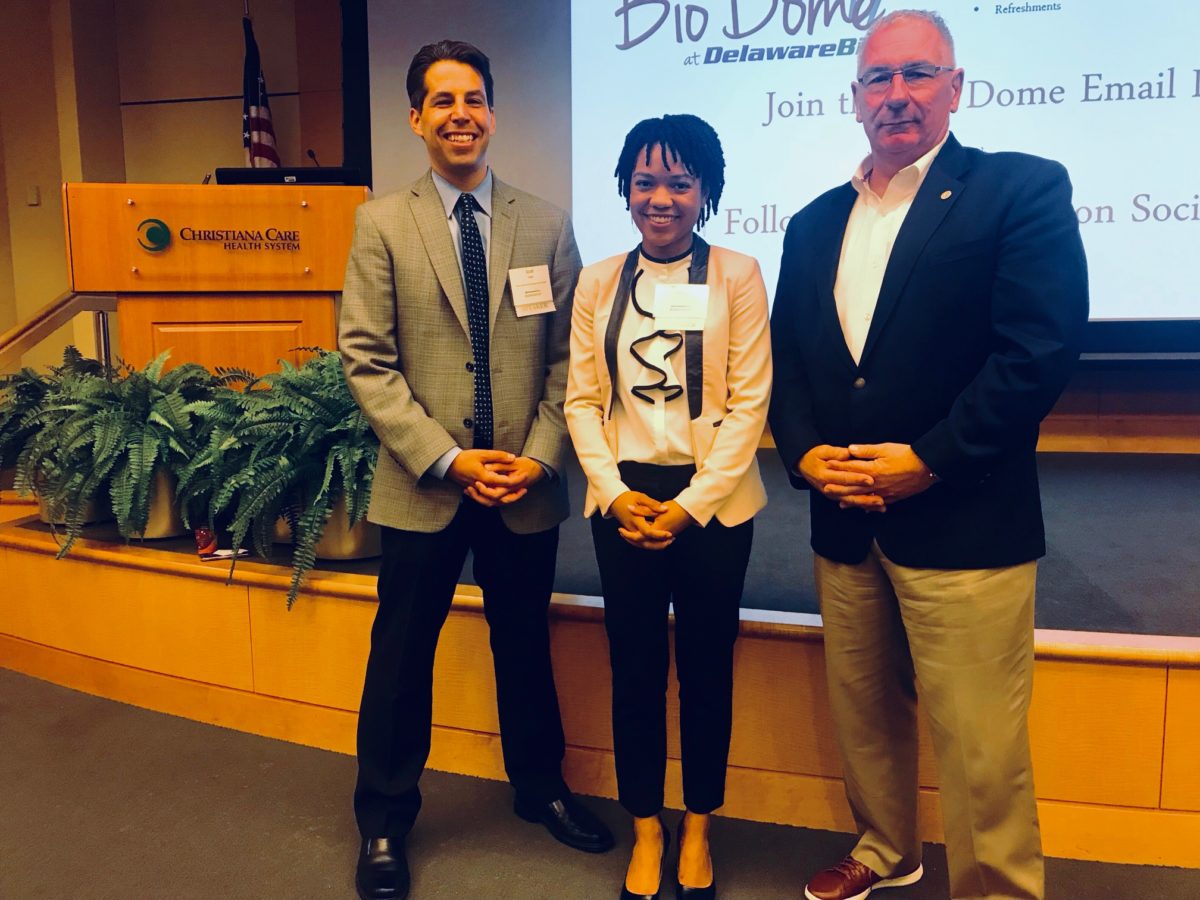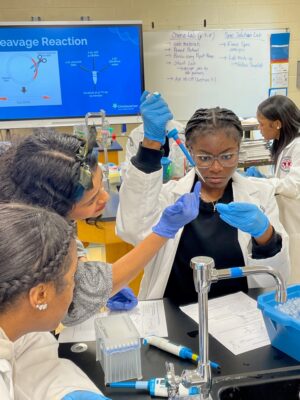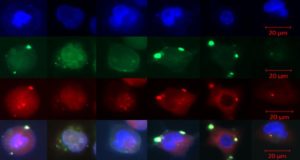On an early Tuesday morning in July, more than 100 people gathered at the John H. Ammon Medical Education Center at Christiana Hospital to hear about eye-opening advances in bioscience and health care.
A gene-editing technology that helps improve cancer treatments.
Digital pills that send data to an iPad app.
The effect your ZIP code has on your health.
These topics and more were covered during the Delaware BioScience Association’s July 17 BioBreakfast, titled “Connectivity & Collaborations.”

Christiana Care was an apt host for an event highlighting collaboration. Christiana Care’s Value Institute is a hub of research activities in the health system, said Scott D. Siegel, Ph.D., director of Population Health and Community-Based Research, which is part of the Value Institute.
The Value Institute also creates partnerships with organizations including patient advocacy groups, industry and academic institutions, and national and international health care systems.
“We’re here to develop, deliver and evaluate innovative solutions that impact population health, patient experience, system performance and policy development,” Siegel said at the start of the BioBreakfast program.
Another example of collaboration is between the Gene Editing Institute, which is embedded in Christiana Care’s Helen F. Graham Cancer Center & Research Institute, and NovellusDx. Based in Israel, NovellusDx provides oncology professionals with the data and insights needed to create a precise, personalized treatment plan for each patient.
The company was interested in the work that the Gene Editing Institute has been doing with CRISPR, a gene-editing tool that can edit a specific set of genes among the tens of thousands contained in an organism’s DNA.
The Gene Editing Institute has been using CRISPR to improve the effectiveness of chemotherapy for lung cancer. NovellusDx was interested in how CRISPR can help with diagnostics.

“There’s the belief that CRISPR will slowly replace some diagnostics because it has this incredible ability to manipulate DNA,” said Gene Editing Institute Director Eric Kmiec, Ph.D.
NovellusDx’s diagnostic tool had a lag time of up to 14 days.
“With cancer patients, two weeks is a long time to get an accurate therapy going,” Kmiec said. Using CRISPR-Cas12a, the institute developed a process that reduced the time to 36 hours. “CRISPR is lightning fast,” he said.
Now NovellusDx has a 10-year license to use the institute’s technology.
Delivering useful data that can improve patient behavior is behind the development of digital pills, the topic of a presentation given by Dominique Medaglio, Pharm.D., a senior clinical researcher with the Value Institute. Medaglio recapped the results of a Christiana Care pilot program using Proteus Digital Health’s Proteus Discover, which was designed to help patients remember to take medication.
The Proteus Discover platform includes a medication with a tiny microchip. As it’s being digested, the technology sends a signal to a small sensor in a patch worn on the stomach.
The patch detects the pill’s unique identification and sends a notification via Bluetooth to a patient iPad, where an application records the medication name and strength, as well as the date and time it was ingested. Along with the patient, health care providers can access the information. If the patient misses a dose, the application sends a notification.
Christiana Care’s pilot program involved patients with heart failure who were comfortable using technology. The patients who completed the program for more than two weeks had an average 80-percent adherence rate, Medaglio said.

What’s more, these same patients had a total of just one hospital visit in the 30 days following the program’s start. Thirty days before the program’s beginning, they had a total of 13 hospital visits. One of the main calls for help had nothing to do with the pill. Instead, callers wanted to know how to turn on the iPad. “That was a bit of a surprise for us,” Medaglio said.
There was another obstacle. States often have different policies regarding compounding (the creation of a personalized medication) and encapsulating (a technique used to enclose medication in a hard or soft capsule). To meet Delaware’s requirements and still include the chip with the medication, the pilot program had to locate an external mail-order pharmacy to encapsulate the two. Consequently, some patients had a co-pay.
“I see this as a clear example of what happens when the technology is ahead of policy,” Medaglio said. “Not every hot technology out there is ready to hit the ground running. There are still some significant barriers.”
Dr. Siegel returned to the stage to talk about the influence of “ZNA” on health care-related policies.
ZNA refers to your ZIP code, and like DNA, it can affect your life expectancy. “There’s a tremendous variability in terms of life expectancy based on where you live,” Siegel said.
He displayed a 2014 map of the United States indicating the average life expectancy by county. There was about a 20-year gap between some areas, where the life expectancy averaged in the 60s, and others, where it was in the 80s.
Problematic areas included West Virginia, Kentucky and along the Mississippi Delta. These sections of the country also had a high cancer mortality rate.
However, there were variations when the criteria focused on lung cancer, pancreatic cancer and liver cancers — which by 2030 will be the leading causes of cancer deaths.
Risk factors for these cancers are related to behavior, he said. Consider the link between smoking and lung cancer.
Research has shown that many smokers have a low income and that there’s a high number of tobacco outlets in low-income neighborhoods.
“Where people spend their time has a huge impact on their behaviors,” Siegel said. “If there are more stores supplying tobacco, you have greater access.” He also noted that the price of cigarettes is frequently lower in these areas, and there are more marketing materials in store windows and at the register. In addition, smoking might be a social norm in the neighborhood.
Policymakers can use geospatial analytics to create intervention strategies, such as instituting tighter tobacco control measures in ZIP codes with a high rate of lung cancer, promoting lung cancer screenings, providing smoking-cessation services and funding research focused on lung cancer treatments.
“I think this was a very informative event,” concluded Helen Stimson, president and CEO of the Delaware BioScience Association, at the program’s close. “I know I learned a lot.”
Nancy J. Kovach, who attended the event, agreed. “I thought the technology about the digital pills was just fascinating,” said Kovach, vice president of Life Sciences Practice at the Salveson Stetson Group, an executive search firm. The cost of non-compliance for people with chronic medical conditions is staggering, she said.
Lisa Wolfington said the program was powerful and inspiring. “I really enjoyed seeing all the new technology and the advances in science and medicine that Christiana Care is involved in,” said Wolfington, director of Health System Marketing for Benchworks. “I was very impressed.”
Sponsors of the July 17 breakfast included the Delaware IDeA Network of Biomedical Research Excellence (INBRE), the Pharmaceutical Research and Manufacturers of America (PhRMA) and VWR International, an American company involved in the distribution of research laboratory products.
For more information on the Delaware BioScience Association, visit http://delawarebio.org.



